|
WNTS, ENTS,
Back at Congaree National Park last February, Bob Van Pelt asked
if I would
join a team of elite climbers and canopy biologists to assist in an
on-going
project in the giant sequoias in California. I tentatively agreed
but did
not commit due to financial woes and other reasons. Bob followed up
with an
email and call stating that the flight out would be funded- all I
needed to
do was commit to the trip. Well, I did, and Dr. Steve Sillett, a la
“The
Wild Trees”, called to express his enthusiasm and welcome me to the
project.
The canopy work of Steve, Bob, and team is legendary. Here is a link
to some
of Steve’s work:
http://www.humboldt.edu/~sillett/.
I was thrilled and honored to be both invited and have the
experience of
climbing with the World’s elite class of canopy researchers. The
Tsuga
Search Project and the mapping of the eastern giants paid off! My
main task
for the trip as a climber would be to do some “mop up” mapping of
deadwood
on two previously mapped sequoias and then assist on the full 3-D
canopy
mapping of the tallest known sequoia, a ~310 footer in Redwood
Canyon, Kings
Canyon National Park. In preparation for the extreme climbing I made
an
effort to exercise and work hard to get into condition. The hard
swimming
and climbing I did paid off well, but I did end up pretty dang beat
by the
end of the week…
I left the mid 60 degree cool rain of Black Mountain, NC to fly
into the
triple digit, dry atmosphere of Fresno, CA a half day later. I was
nervous
about the immensity of the trees I had never seen before and the
knowledge
of the intense process at hand. I knew it would be challenging but
fortunately I was “up to speed” on the mapping process and had
climbed and
was acquainted with the key members of the team. Frankly, the
weather was
more of a concern than the climbing- I absolutely despise dry, sunny
conditions. Thankfully, the high elevation of the site proved to be
quite
pleasant.
I arrived after a long flight late on July 1st. Bob picked me up
and we
drove up into the mountains to a property owned by the University of
California, Berkley. The site, named Whitaker Forest, is a research
station
and center for forestry. Check it out:
http://forestry.berkeley.edu/whitaker.php. Formerly a resort,
there is a
small cabin remaining among the ruins of other structures. The cabin
was the
epicenter of the project and provided a place to cook, hang-out, and
process
data and samples. The cabin was tucked in among giant stumps of
sequoias cut
in the 1870’s. In fact, this area was the site of the first
commercial cut
of sequoia and as such provides the oldest regenerating sequoia
grove from
which to study. Several trees in the vicinity of the cabin are study
trees.
The differing age classes allow a study of the species through time-
and
allowed me the opportunity to see the morphological change as the
trees age.
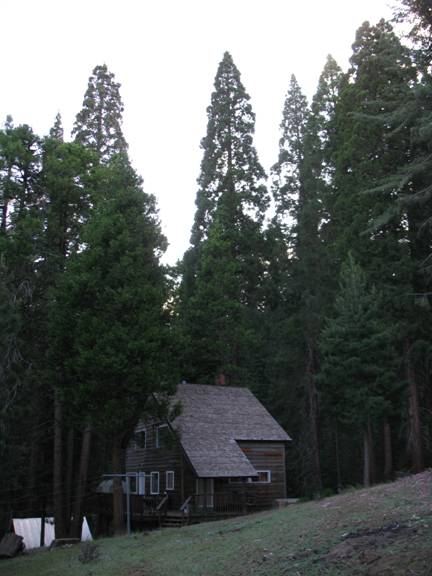
Cabin among the sequoias

Huge stumps of felled giants; sugar pine on left
I had never seen sequoia forest and the drive up in the dark did
it no
justice. In the morning I awoke to my first Sierra scene. The misty
morning
fog and tranquil forest sounds welcomed me like no where else. The
silence
was deep and the air dead calm. The immense relic sequoias and
vibrant
younger trees gave a sense of the productivity of this place and the
promise
of future giants. I began to access the crown forms and imagine the
coming
days in the trees. The extreme height and size of the branches
certainly was
new to me. I felt so small- much like a squirrel must feel back east
in the
“little” hemlocks I have spent so much of my time in. The
second-growth
sequoias in the yard of the center were far larger in volume and
much taller
than the super-hemlocks documented in the Tsuga Search. My perceived
world
of the trees had been set back ~90%.

Good morning California! 200 foot+ Second-growth adjacent to cabin
I looked out among the camp to familiarize myself with the
species. Incense
cedar, sugar pine, California white fir, and ponderosa pine were
mixed in
with the sequoias. Alder and several oak species comprised the
majority of
the hardwoods but were quite diminutive and subordinate in stature
beneath
the towering conifers. Rouge cows were grazing among the giant
stumps- some
cut 25 feet high to avoid fire scars.
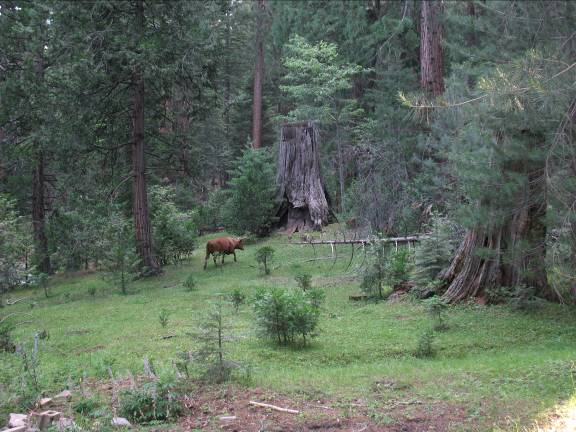
Cows grazed illegally in the forest
The team assembled to prepare the equipment and discuss logistics
for the
coming days. One team was to install monitoring equipment in some of
the
tallest trees to assess sap flow and other canopy dynamics. Bob,
Steve and
his wife Marie Antoine and I were to climb one of the tallest known
sequoias- a 298 footer next to a slightly taller tree (301 feet) in
a pair
called the Twin Towers. These trees stand but a few dozen feet from
each
other and form an imposing wall of wood. The tops of these two trees
were
featured on the cover of the latest Sherrill Tree catalogue. Tobe
Sherrill
was to arrive later in the week. His website has some images from
past
trips- including a climb in the Smokies with Steve, Marie and me.
www.sherrilltree.com <http://www.sherrilltree.com/>
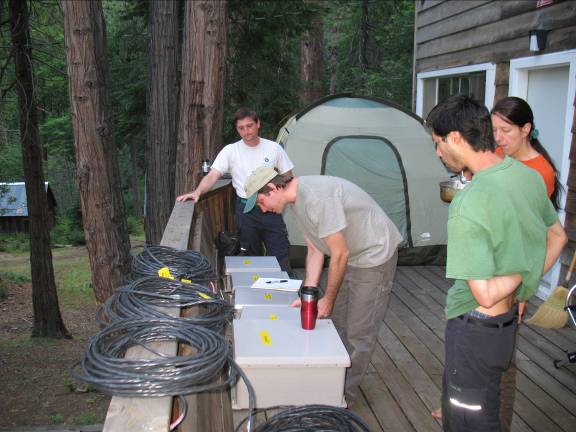
Steve Sillett, Anthony Ambrose, Cameron Williams and Rikke (sorry
about
spelling!) prepare sampling equipment
The tree we climbed first- named Snoopy**- was the first sequoia
I had ever
climbed. Steve warned of the hazards of exfoliating bark, sharp
needles and
super-weak deadwood and smaller branches. My naďve impression of
these
giants was one of tenacity, strength and stoutness. I left with an
entirely
different impression. Little did I know that brittle and “foamy”
would be
more appropriate!

The “Twin Towers”. Snoopy on right
Although a tiny tree relative to the giants of the species, the
16 foot
diameter of Snoopy was absolutely massive. The adjacent tree was
even
bigger and the two side-by-side adequately humbled me. I watched and
photographed in silence as Steve and Marie rigged the lines and
began the
initial ascent. I watched as they ascended the trunk and was
astonished at
how small they were against the trunk. Steve looked like an ant as
he passed
3 foot thick limbs at nearly 200 feet up. I really, really had no
idea how
big these trees were. Seeing them from the ground is one thing- to
see a
human up in the canopy and then go to the canopy yourself is an
immersion in
hhumility. These giants are so imposing and we humans just a passing
flea.
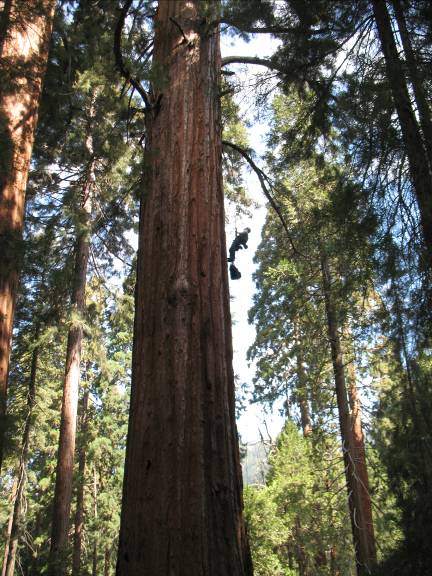
Steve on ascent of Snoopy

Cameron’s ascent of the neighboring tree. Not an aficionado of
Tolkien
names- I do not recall its name…

Marie prepping the rope for ascent of Snoopy (on left)
My turn came to ascend Snoopy. I hitched up my ascension gear
and headed
up. I was appreciative of the static line I was ascending- I would
have been br>
on a 280’ rubber band otherwise. The ascent was in a sense a slow
tour of
the entire tree. I took my time and enjoyed the changing view of
both the
trunk and the forest scene out and below. The thick, red bark was
like foam
and had a hollow, spongy feel. It fell off in sheets and was rather
light
and delicate. A slow gradation from 2 feet thick and furrowed to a
mmillimeter thin and scaly was observed from the base to the top.
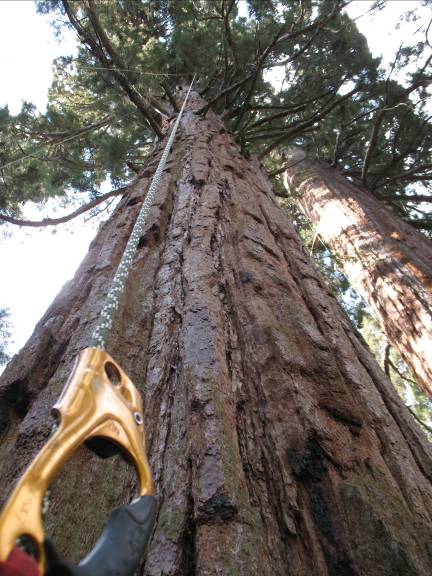
Going up!
I am always interested in forest textures as seen from above. The
diversity br>
and textures of the eastern forests is not often appreciated from
above. Not
much I can do about that though. The firs and their whorled branches
were
beautiful and the bright green of the new growth was striking
against the
red bark of the sequoias. Bob was commenting on the Sierra’s forests
being
very primary in the color schemes. This is very true. Red bark, blue
sky,
green needles, white snow and black charcoal compose the vast
majority of
the landscape. The crystal air and clear sunshine brought these
attributes
oout in vibrant clarity. It was beautiful.
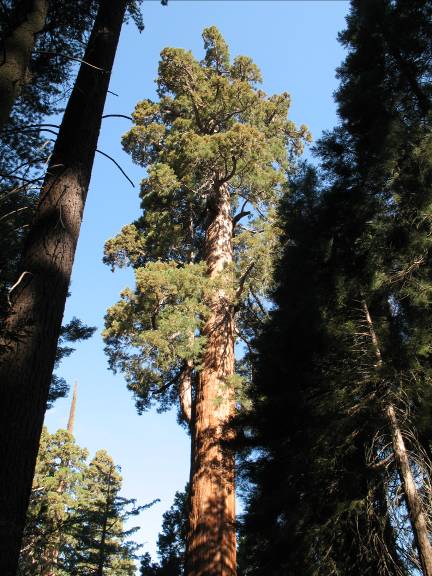
Green, red, blue. Note rusty color of dead top in lower left.
As I entered the lower canopy at ~150 feet I got my first glimpse
of the
gnarlage and complexity of these giants. Snoopy is believed to be
nearly
2,000 years old and it showed. Fires had stripped much of the trees’
original branches and the resulting crown was composed mainly of
epicormic
sprouts. However sprouts are a relative term as several of these
“new”
structures were over three feet thick. These sprouts gave rise to
reiterations and huge branches that cascade, stick straight out, or
traverse
the canopy in seemingly random fashion. Many of the branches
descended and
then upturned with a graceful sweep. The term Steve used for the
canopy
structure is “foraging for light”. This makes sense as the species
is not
tolerant of shade. These trees must be the arboreal realm’s epitome
of
efficiency in their use of sunlight- and it shows in their
architecture.
Light interception and efficient use of space is the definition of
the crown
structure. All trees are like this but when you are in such a huge
tree it
becomes that much more clear. We had fun tracing these intricate
structures
through the crown- and especially in the mapping of the tallest tree
later
in the week- made for some interesting mapping decisions. At times
we had to
ask the team on the other side of the 8 foot diameter trunk where a
certain
sstructure went. You can’t see through a wall of wood.

Bob Van Pelt coming up Snoopy
As I approached the top of Snoopy the expression of time and
history was
strongly evident. You could view in the complex architecture of
living and
dead wood perhaps a millennia of growth, death, regrowth- all with
strong
intent to persist. This tree- like many giant sequoias- was pummeled
over br>
the centuries by storm and fire into a complex assemblage of
deadwood, dead
trunks and living wood with new tops. Undaunted by the death of
their tops,
they over the course of perhaps several centuries simply grow a new
one. The
decay resistance of the wood allows for the persistence of the old
structures and the relics of time past to still be seen today. This
also
allows for core samples to be taken to help recreate the history of
these
ggiants. Some of the deadwood could be sub-fossil and hundreds of
years old.

Central stem of Snoopy at about 260’ up
As I left the ascension rope and switched to my typical arborist
setup the br>
first of the perils of sequoia climbing came into stark reality-
exfoliating
bbark. Let me tell ya, these trees are designed to shed fire by
allowing
pieces of burning bark to fall off with the intent of shedding the
flames br>
and not allowing them to climb up the tree. Well, this nifty little
feature
also works well on climbing humans. You can’t just grab a branch
thinking
you can hold on under any lateral pressure. You will be promptly
shed. Same
with standing on a branch with any kind of side loading. You will
slide off.
LLesson #1 learned the hard way. Ropes are good.

Steve and Marie mapping deadwood in the top of Snoopy. Note
exfoliating
bark! br>
I also soon found out my six foot cambium saver was nearly
inadequate. This
only allowed for placement over a limb or branch ~2 feet diameter.
There
were not many of these. They were bigger. Regardless, I had 200 feet
of rope
which allowed me to work ~100 feet of crown before needing to reset.
Traversing the canopy was much like an aerial and vertical skating
event.
The intricate balance of gravity, lateral loads, slippery bark and a
couple
hundred feet of airspace made for an exciting and challenging
experience.
Encountering wood I could not get my arms around was a new
experience. Even
if I could get my arms around it the bark would negate any vertical
mmovement. Might as well try to climb over a greased pole. Without
ropes
these trees are unclimbable.
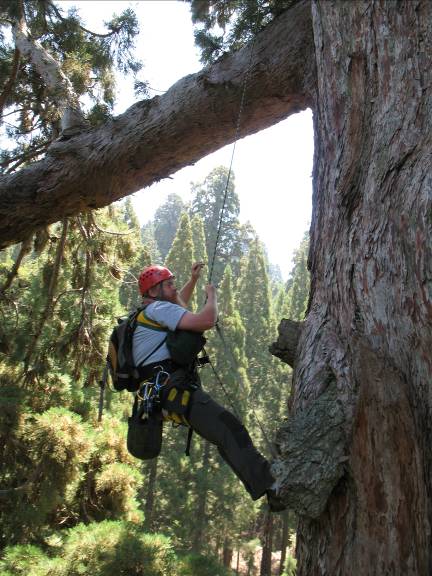
Bob Van Pelt with background of young sequoias
Steve and Marie were experienced in the sequoia characteristics
and I
quickly caught on. Bob and I were a mapping team and we focused on
mapping br>
deadwood from the top down. Some of these pieces were the size of
sofas and
perilously hanging by a few fibers of sound wood. The deadwood on
these
beasts has an unnerving combination of some frightening
characteristics.
One, they are huge. Two, they are very, VERY brittle and calve off
in huge
chunks at times without warning. The surface of these ancient pieces
of wood
is cracked and speckled in a bright yellow lichen- one of the few
epiphytes
in these trees. Makes sense- the deadwood is the only surface not
regularly
shedding. Thus, we had to be very conscious of the location of the
other
team and make sure they were NOT underneath any dead structures
being
mapped. After mapping, for safely of the climbing to commence below,
some of
the more sketchy pieces were knocked off- often with alarming ease.
The hiss
of the long descent and delayed thud upon cratering on the ground
emphasized
the height of these trees. Also, green sequoia cones are heavy.
These little
missiles reach terminal velocity within the crown and whiz by with a
frightening “whoosh!” We all wore hardhats of course and fortunately
no one
wwas hit.
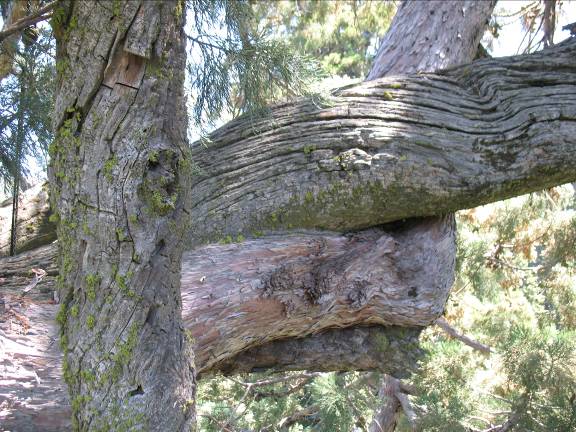
Deadwood and “new” epicormic sprout.
From the top of Snoopy I was commenting to Bob on a massive,
gnarly tree
upslope with TONS of character. It truly looked like a healthy head
of br>
broccoli. He calmly stated that that was tomorrow’s tree, and I
would LOVE
it! Named Red Barron, it was one of his favorite trees and is believed to
be well
oover 2,000 years old. I was psyched for tomorrow!
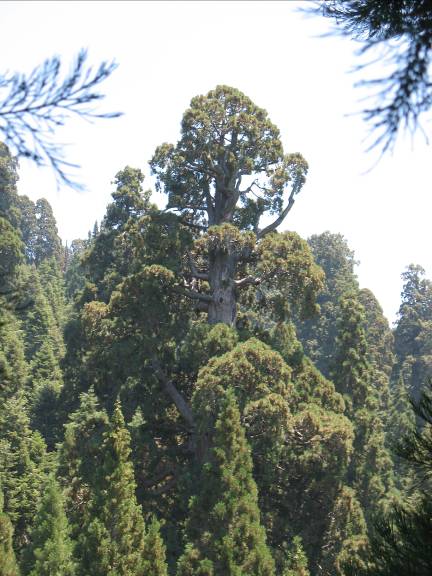
The gnarly beast- Red Barron! Tune in for the next days installment…
Will F. Blozan
President, Eastern Native Tree Society
President, Appalachian Arborists, Inc.
(**Note: The names of the trees were altered in this report
to preserve their anonymity)
Continued
at:
http://groups.google.com/group/entstrees/sg/37290b4b9dff4c14?hl=en%F3%8D%BB%BBfd9146682a&
http://groups.google.com/group/WNTS/browse_thread/thread/0e0d212cd458e135?hl=en
|